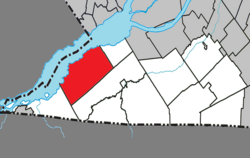Saint-Anicet
Saint-Anicet | |
|---|---|
 | |
 Location within Le Haut-Saint-Laurent RCM | |
| Coordinates: 45°07′N 74°21′W / 45.12°N 74.35°W[1] | |
| Country | |
| Province | |
| Region | Montérégie |
| RCM | Le Haut-Saint-Laurent |
| Constituted | July 1, 1855 |
| Government | |
| • Mayor | Alain Castagner |
| • Federal riding | Beauharnois—Salaberry |
| • Prov. riding | Huntingdon |
| Area | |
• Total | 180.20 km2 (69.58 sq mi) |
| • Land | 135.33 km2 (52.25 sq mi) |
| Population (2016)[citation needed] | |
• Total | 2,626 |
| • Density | 19.4/km2 (50/sq mi) |
| • Pop 2011-2016 | |
| • Dwellings | 2,088 |
| Time zone | UTC−5 (EST) |
| • Summer (DST) | UTC−4 (EDT) |
| Postal code(s) | |
| Area code(s) | 450 and 579 |
| Highways | |
| Website | www |
Saint-Anicet is a municipality in Le Haut-Saint-Laurent Regional County Municipality in the Montérégie administrative region of Quebec. The population as of the Canada 2011 Census was 2,523.
Geography
Saint-Anicet is located in the southwestern Montérégie region of Quebec, on the south shore of the Saint Lawrence River.
Communities
The following locations reside within the municipality's boundaries:[1]
- Cazaville (45°05′11″N 74°22′17″W / 45.08639°N 74.37139°W) – a hamlet in the southern portion of the municipality on Route 132.
- Plage-Somerville (45°05′15″N 74°25′31″W / 45.08750°N 74.42528°W) – a hamlet located on Baie de Somerville in the Saint Lawrence River.
- Pointe-Leblanc (45°04′30″N 74°26′26″W / 45.07500°N 74.44056°W) – a hamlet located along the Saint Lawrence River.
- Port Lewis (45°10′14″N 74°16′59″W / 45.17056°N 74.28306°W) – a hamlet located along the Saint Lawrence River on Route 132.
Lakes and rivers
The following waterways pass through or are situated within the municipality's boundaries:[1]
- Rivière La Guerre (45°08′40″N 74°21′03″W / 45.14444°N 74.35083°W) – runs in a southeast to northwest direction to the Saint Lawrence River.
Demographics
Population
| 2011 | |
|---|---|
| Population | 2,523 (-7.1% from 2006) |
| Land area | 135.16 km2 (52.19 sq mi) |
| Population density | 18.7/km2 (48/sq mi) |
| Median age | 51.9 (M: 52.8, F: 50.9) |
| Private dwellings | 1,965 (total) |
| Median household income | $42,911 |
| Year | Pop. | ±% |
|---|---|---|
| 1991 | 2,215 | — |
| 1996 | 2,549 | +15.1% |
| 2001 | 2,630 | +3.2% |
| 2006 | 2,717 | +3.3% |
| 2011 | 2,523 | −7.1% |
| 2016 | 2,626 | +4.1% |
Language
| Canada Census Mother Tongue Language - Saint-Anicet, Quebec[7] | ||||||||||||||||||
|---|---|---|---|---|---|---|---|---|---|---|---|---|---|---|---|---|---|---|
| Census | Total | French
|
English
|
French & English
|
Other
| |||||||||||||
| Year | Responses | Count | Trend | Pop % | Count | Trend | Pop % | Count | Trend | Pop % | Count | Trend | Pop % | |||||
2016
|
2,625
|
2,125 | 80.95% | 395 | 15.05% | 50 | 1.90% | 50 | 1.90% | |||||||||
2011
|
2,525
|
2,040 | 80.79% | 395 | 15.64% | 40 | 1.58% | 50 | 1.98% | |||||||||
2006
|
2,715
|
2,250 | 82.87% | 310 | 11.42% | 45 | 1.66% | 110 | 4.05% | |||||||||
2001
|
2,590
|
2,060 | 79.54% | 355 | 13.71% | 80 | 3.09% | 95 | 3.67% | |||||||||
1996
|
2,520
|
2,005 | n/a | 79.56% | 450 | n/a | 17.86% | 30 | n/a | 1.19% | 35 | n/a | 1.39% | |||||
Historic site and museum

In the south of Saint-Anicet, the Tsiionhiakwatha/Droulers archaeological site interpretation center is where an important Iroquoian village in Quebec was located. Circa 1450, approximately 500 St.Lawrence Iroquoians established a village near the La Guerre River. The centre opened on May 15, 2010.[8]
Droulers-Tsiionhiakwatha was designated a Site du patrimoine constitué under provincial legislation in 2005,[9] and a National Historic Site of Canada in 2007.[10]
See also
References
- ^ a b c "Banque de noms de lieux du Québec: Reference number 55616". toponymie.gouv.qc.ca (in French). Commission de toponymie du Québec.
- ^ a b Ministère des Affaires municipales, des Régions et de l'Occupation du territoire: Saint-Anicet
- ^ Riding history for Beauharnois—Salaberry, Quebec from the Library of Parliament
- ^ a b "2011 Community Profiles". 2011 Canadian census. Statistics Canada. March 21, 2019. Retrieved 2014-02-01.
- ^ "2006 Community Profiles". 2006 Canadian census. Statistics Canada. August 20, 2019.
- ^ "2001 Community Profiles". 2001 Canadian census. Statistics Canada. July 18, 2021.
- ^ a b Statistics Canada: 1996, 2001, 2006, 2011 census
- ^ Tsiionhiakwatha/Droulers Archaeological Site Interpretation Centre Archived 2010-06-05 at the Wayback Machine
- ^ Site archéologique Droulers-Tsiionhiakwatha. Canadian Register of Historic Places. Retrieved 24 March 2012.
- ^ Droulers-Tsiionhiakwatha National Historic Site of Canada. Canadian Register of Historic Places. Retrieved 24 March 2012.
External links
- Virtual Museum of Canada, The St. Lawrence Iroquoians — virtual exhibit about the St. Lawrence Iroquoian people, based on the archaeological excavations at the Droulers/Tsiionhiakwatha site.

